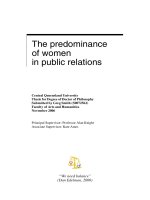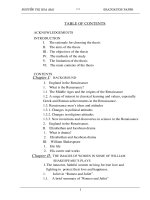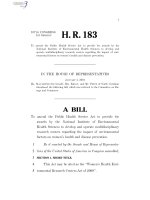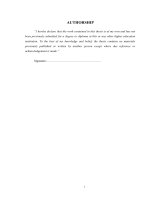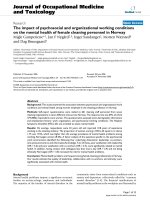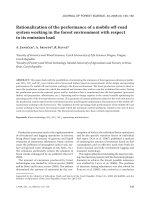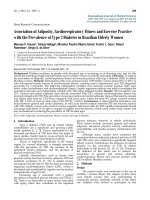The negotiation of motherhood amongst malay working women
Bạn đang xem bản rút gọn của tài liệu. Xem và tải ngay bản đầy đủ của tài liệu tại đây (427.04 KB, 116 trang )
THE NEGOTIATION OF MOTHERHOOD AMONGST
MALAY WORKING WOMEN
NUR HAFIZAH BTE RAFIE
(B.SOC.SCI (HONS)), NUS
A THESIS SUBMITTED
FOR THE DEGREE OF MASTER OF SOCIAL SCIENCES
DEPARTMENT OF SOCIOLOGY
NATIONAL UNIVERSITY OF SINGAPORE
2011
ACKNOWLEDGEMENTS
Writing this thesis has been an enriching and a self-discovery experience for me. Getting
to know women from all walks of life has taught me that balancing work and family life
requires a lot of patience and perseverance.
I would like to thank the following people who had helped me with this thesis in one way
or another:
My supervisor, Associate Professor Roxana Waterson, for patiently guiding and advising
me for the past two years especially during the writing stage. Without her guidance this
thesis would have been an overly passionate and incoherent rant.
The NUS sociology graduate students, Allan, Christopher, Ryan, Fadzli, Wayne, Dean,
Hai Ha, Lynette who have helped me shape my sociological thinking in the various
modules that we took.
My writing companion, Victoria, for accompanying me to write at Coffeebean whenever
I need a change in environment.
My family and friends for giving me unwavering support throughout these years.
Special thanks to Yurni, Suhaily, Hidayati, Syahidah, Siti Haida and Nurulhuda who
helped me to obtain informants for this research.
Most importantly, to my respondents, who were kind enough to share with me their trials
and tribulations, joys and happiness experienced. Without their insights, I will not have
the data to work with for my research.
Lastly, I would like to thank Juma’at who has been constantly encouraging me for the
past two years especially when things seem impossible to achieve.
TABLE OF CONTENTS
Acknowledgements
Table of Contents
Summary
List of Tables
i
ii
iv
v
Chapter 1 – Introduction
1.1 Statement of the Problem
1.2 Aims and Research Questions
1.3 Rise of Dual-Income families
1.4 Methodology
1.5 Overview
1
2
4
7
10
Chapter 2 – Historical and Cultural Variations in the Ideology of Motherhood and
Childhood
2.1 Motherhood within a Consumerist Society
2.2 The Emergence of the Sacred Child
2.3 Role of mothers in Islam
2.4 Mothering and Social Class
2.4.1 Habitus
2.5 Impact of Different Mothering Discourses on Working Women
11
16
20
22
24
25
Chapter 3 – Historical Context of Mothering in the Malay World
3.1 The Role of Women in Malay Families in Malaysia
3.1.1 Women in Rural Areas
3.1.2 Women in Urban Areas
27
27
29
3.2 Malays in Singapore
3.2.1 Socialization of Malay Children
31
35
3.3 Status of Women in Singapore
39
Chapter 4 –Class Differences in the Mobilization of Social Networks
4.1 Different Childcare Arrangements
4.2 The Involvement of Fathers across Class
45
51
Chapter 5 – Childrearing Practices across Class
5.1 Different Childrearing Practices
5.2 Different Emphasis on Education
56
63
ii
Chapter 6 – Class, Culture and Religion in Childrearing Patterns
6.1 Class, Religion and Malay Identity
75
Chapter 7 – Finding a Balance Between Work and Mothering
86
Bibliography
96
Appendices
Appendix A – Interview Questions
Appendix B – Profiles of Interviewees
102
104
iii
SUMMARY
This research aims to shed light on how Malay working women with children shoulder
home and familial responsibilities while negotiating identities and practices as workers
and mothers in everyday life. I examine and discuss the ways that motherhood has been
constructed as meaningful in the everyday life of working women from different income
groups, and how they practise their mothering. Forty in-depth interviews were carried out
with working mothers from different income groups. The Malays in Singapore may face
particular problems because there is a large part of the community who have not received
university education, and they are disproportionately represented in low-paying jobs.
Thus, if women are working long hours as well as doing the housework, they may be
finding it harder to have quality time with their children. Cultural and religious factors
also influence how women see their roles as mothers. This study offers fresh insights into
how working Malay women juggle their roles, showing how the notion of being a good
Muslim mother may be intertwined with how they practise their mothering. The study
also pays close attention to class differences in the structural constraints faced by women,
the means available to them to help them cope with the joint demands of work and
childrearing, and the styles of mothering adopted. Malay working women’s experiences
are shown to be in some ways similar to those of women of other ethnicities, and in
others rather distinct. The study thus makes a new contribution to sociological inquiry by
illuminating the interconnections between gender, cultural, class and historical
differences which entangle the category of woman as a singular form.
iv
List of Tables
Chapter 3
Table 3.1 Median Household Income by Ethnic Group, 2005 (p.32)
Table 3.2 Monthly Household Income by Ethnic Group (p.32)
Chapter 4
Table 4.1 Current Maximum CFAC subsidies (p.49)
Chapter 5
Table 5.1: Kindergarten Financial Assistance Scheme (p.70)
v
Chapter 1: Introduction
1.1 Statement of the Problem
As Singapore has modernized and transformed its economy and encouraged
women to enter the workforce, more women are juggling the demands of paid work
and family responsibilities as a wife and mother, which places them at risk for
parenting role conflicts and stress. The demands of work sometimes take priority over
marriage and family life and these demands also intrude on the privacy and sanctity of
domestic life. Balancing work and parenthood has been seen as a special problem and
a dilemma for women because traditionally, women are seen to be the ‘natural’ carers
for their children, while men are expected to work to provide for the family. The
concept of mothering is a historically and culturally variable relationship in which one
individual nurtures and cares for another. The notion of motherhood is tied to the
notion of gender in which a socially constructed concept of relationships and practices
are organized around the perceived differences between what a male and a female
should be. This gendered allocation of mothering developed from an essentialist
interpretation which views mothering as natural, universal and unchanging. An
ideology that places mothering exclusively in the private, emotional realm creates
conflicts for mothers who are holding full-time employment. Mothers have identities
and activities outside of and in conjunction with mothering.
In Singapore, the notion of balancing work with family life has been an
important issue as the total fertility rate in Singapore has been falling below
replacement levels. There are fewer couples who want to be parents or want to have
more than 2 children since raising a ‘high quality’ child is now seen to require a heavy
investment of resources and parental energy (Jones et. al. 2009). Mothers who are
working long hours may feel conflict due to the restricted time they are able to spend
1
with their children to nurture them and help with their education even though they are
working. This research will examine how Malay working women have to deal with
intertwined cultural and religious expectations of being a mother. It will also explore
how far women of lower income may find themselves under additional pressure in
balancing their role as a mother and worker due to lack of resources.
It is important to understand how working women negotiate motherhood and
work as it involves the interconnections between gender, cultural, class and historical
differences which complicate the category of woman as a singular form. As there is a
lack of previous studies on how Malay women cope with motherhood and work, this
study attempts to shed light on how current labour policies may affect working
women with regard to work-life balance. Apart from that, this study seeks to
understand how working mothers from low-income families negotiate their role as a
mother and worker since these women have fewer resources than women with higher
family income, and will have less time to adhere to an ideology of intensive
mothering. This thesis hopes to illuminate problems related to work-life balance and
shed some light on the existing weaknesses in childcare and preschool coverage for
people in the lower income brackets.
1.2 Aims and Research Questions
Mothers from different social backgrounds may experience motherhood
differently and have different understandings of what motherhood means. Thus, I
wish to investigate if there is a certain ideology of motherhood that these working
mothers adhere to, and what are the negotiating processes in which they engage in
their social construction of everyday life. The concept of motherhood as an ideology
and the value of raising well-rounded children will be examined. I will also look at
how the state’s policies play an important role in shaping how working women
2
negotiate motherhood. Resources such as social networks and kin relations, structured
resource provision and the availability of information play an important role. Thus, I
will look at how mothers from different socio-economic statuses would have access to
different types of resources which may help or hinder them in negotiating the notion
of motherhood. Apart from that, I will be exploring the emotions that mothers have to
negotiate and re-negotiate with themselves in trying to accept the whole notion of
motherhood.
In comparing mothers from different social backgrounds, I will examine how
the cultural capital of mothers from each social class, would affect differently the way
these mothers negotiate some kind of balance between motherhood and their working
life. Comparing women of different social classes, the ideas and beliefs about how
women should care for their children and juggle with their work life are likely to be
different. This is because the knowledge that women have about reproduction and
childrearing comes from a wide variety of different sources, and the advice they
receive from some of these may be conflicting with what they have been brought up
to believe (Richardson 1993: 18). For a working mother, even though she has her
career to pursue, society still expects the mother to be fully responsible for her child’s
well-being and to be actively involved in the children’s education. Furthermore in
Islam, the role of a mother is emphasized three times by the Prophet which places the
main burden of parenting upon the mother. In Islam, mothers are expected to educate
the children well with good Islamic values. She is the main person responsible for her
children’s development. With this big responsibility expected of Muslim mothers, it is
important to study how working Malay women juggle their roles as a mother and
worker as the notion of being a good Muslim mother may be intertwined with how
they practise their mothering. Apart from that, there are also Malay cultural
3
expectations embedded within the Malay kinship system, that the mother has to be the
main caregiver for the children. In the Malay family, the flow of nurture from parent
to child is seen as both obligatory and voluntarily bestowed with no thought of return.
The voluntary aspect of the parent-child relationship is fundamental, since any adult
who is willing to take on a nurturing role towards a child and to help the child lead an
independent, adult existence is a socially recognized parent (Li, 1989).
1.3 Rise of Dual-Income Families
In the 2009 Ministry of Manpower Report, 24.1 % of females in the age group
of 25-29 years old have a diploma and professional qualification, while 23.3% have a
university degree. For females within the age group of 30-34 years old, 17.4% are
diploma holders and 24.7% are university graduates (Ministry of Manpower 2010).
With more females attaining higher education, one will expect that the female labour
force participation rate will increase. Over a span of eighteen years, the percentage of
Singaporean women who are working full-time has risen from 48% in 1991 to 55.2%
in 2009 (Ministry of Manpower 2010). According to the 2005 General Household
Survey conducted by the Department of Statistics, 38.5% of females who are married
are active in the labour force. An immediate implication for the household is that
there are two income earners. With an increase in the number of women in the
workforce, the combination of work and caring for the family has become an
important issue in the lives of dual-income families especially those with young
children.
According to past research, there is considerable variation in how women
negotiate their role as a mother and carer, which may be consistent with differences in
their educational level (Debacker 2008: 528). Mothers with different qualifications
4
appear to make variable choices with regard to the combination of work and caring
activities. Debacker’s study (2008), which was carried out in Belgium, showed that
low-skilled mothers tend to withdraw temporarily from the workforce after the birth
of a child, while the well-educated women tend to outsource some childcare activities.
These well-educated women could afford to send their children to childcare centres,
rather than sending them to be looked after by their relatives. Care time has different
rhythms and constraints than labour market time. Care for children has multiple time
dimensions, some of which are relatively inflexible. Many caring tasks are continuous
and non-negotiable such as supervision, feeding and facilitating education (Maher et.
al. 2008: 549).
Conditions in Singapore are likely to differ from those in Debacker’s study.
Yeoh and Huang (1995) conducted a study to examine childcare preferences amongst
the three major ethnic groups in Singapore by looking at families living in Bishan
which comprises residents living in the HDB flats and private housing estates. The
sample is based on a random survey of 560 mothers comprising 255 housewives and
305 full-time working women. Based on this study, most working women are unable
to be the main caregiver during the working day and resort to a wide range of
childcare strategies. The most common modes utilized by working women include the
use of grandparents, weekly babysitters, childcare centres and live-in maids. Malay
working mothers prefer to let their parents care for their children instead of sending
them to childcare centres. Around 22.2% of Malay mothers discounted the childcare
centres for fear that their children will learn undesirable socio-cultural values at these
centres. Their main concern is that the food served during mealtimes is not halal
(Yeoh and Huang 1995: 454). The other main issue that these mothers have with
some of the childcare centres within their vicinity is that the centres are run by
5
organizations with Christian roots. Due to this, Malay mothers are unwilling to send
their children to centres with a different socio-religious milieu (Yeoh and Huang
1995: 455). Malay families, who live far from their parents, will send their children to
a babysitter who is of the same ethnicity (ibid.). The Chinese and Indian mothers are
more willing to send their children to childcare centres as they do not have any
cultural issues about them.
Uttal (1999) in a study that examined kin-based childcare amongst Hispanic
and African-Americans in the United States, shifts her focus from the individual
needs that have been given prominence in earlier studies to the dynamic family
processes that are shaped by the contexts of class, race and gender within which they
are situated. The embedment in extended family socioeconomic networks suggests a
new framework for understanding the criteria used by employed mothers to make
their childcare choices (Uttal 1999: 855). The use of kinship networks means that
cultural differences in the orientation towards kin-based child care continue to exist
and influence different practices in ethnic minority families.
If society and state policies continue to hold lightly to a more conventional
ideology of what a good mother should be, this poses a contradiction for working
mothers who cannot simultaneously stay at home full-time. According to Hochschild
(1990), women often work two shifts, doing both their paid job at their workplace and
their unpaid job at home. Due to the unfeasibility of keeping their work and family
life separate, women are constantly “shifting gears” in order to meet expectations in
each domain. This creates tension for women, especially in Asian societies where
patriarchal gender ideologies and cultural ideals have tended to be deeply embedded;
it will not only deepen the divide between the public and the private but it may also
6
cause the women in these societies to embrace the qualities of good mothering and
add extra pressure to themselves to fulfil both roles (Devasahayam and Yeoh 2007).
Denise Segura (1994) studied Hispanic mothers in the United States. She
describes working-class women as having always to focus their energies on working
outside the home rather than fulfilling the socially-constructed ideal of the full-time,
stay-at-home mother, an image that belongs to the middle class. These mothers do not
have so much time for their children. She found some working parents threw
themselves into their work as they see the home and family life as sources of
unending demands, stress and tension, while identifying work as a place marked by
pleasant relationships and peer support groups. The division of labour is also
complicated by asymmetries in power and problematic negotiations over the division
of emotional labour. It is inevitable that women with children have to deal with these
two spheres of life. The spill-over effects from one domain into the other are
inescapable. Given the insight that gender, family and work are not natural, universal
and unchanging categories, we may conclude that it is necessary to examine how
women’s and men’s actions and interactions, identities, beliefs and ideas, and the
varying social, economic and political institutions, shape women’s experiences in
their capacities as mothers.
1.4 Methodology
This study begins from a Weberian methodological standpoint of Verstehen,
where there is an attempt to interpret the social phenomenon in terms of the meanings
my informants bring to their lives and social actions. It will focus on subjective
experiences, definitions, symbols, metaphors and descriptions of my informants.
Data were collected from 40 married Malay women between ages of 23 to 42
years old who are in full-time employment. The sample for this study is a purposive
7
sample as it targets working women from dual-income families who have children
between the ages of 6 months and 6 years old. This age group is associated with
intensive parenting where the child is groomed to have a well-rounded development
before he/she enters primary school education. Hence it is important to study mothers
with children in this age group to examine if there are differences in childrearing
practices. As far as possible, I aimed to get an even spread across income brackets.
I obtained access to my informants through friends, kindergartens, a family
service centre and an online group for working mothers. They were assured at the
beginning of the interview that the information they gave would be kept confidential,
in order to ensure that their responses would be frank and honest. I interviewed 15
mothers from working-class backgrounds, in which the monthly gross income for
each household is less than $2,500 and the mothers’ highest education qualification is
GCE ‘N’ Level. The mothers in this group are between the ages of 23 to 42. 11 of the
women were in their twenties, while the other 4 women were between the ages of 36
to 42 years old. The women in the lower income group tend to marry at an earlier age
as compared to the higher income group. Refer to Appendix B for interviewees
profile.
The other 25 mothers were women who are university graduates and are
currently working as teachers and managers. For this group of mothers, the monthly
gross income per household is around $5,000 and above. The women in this group are
between the ages of 27 to 38 years old. For both categories, the husbands have the
same educational qualification as the women. Being a person who is not yet a parent,
I may be seen as an outsider particularly to issues pertaining to motherhood, which
allows me to ask questions freely and perhaps give a fresh perspective on this social
phenomenon.
8
Informants were asked about the effects of their jobs on their roles as a mother
and wife. Probes were used for each question in order to obtain more detailed
answers. Some questions that I asked during the interviews included whether they felt
that work caused them to miss out on some of the pleasures of being a parent, and
whether they feel that there is a conflict in their role as a parent and a worker. Aside
from that, I also asked about their relationships with their spouses, such as how
childcare tasks were divided, whether they were able to spend quality time with their
spouse, and whether they confide in their spouse whenever they find life stressful.
The women described to me what their working hours are like and how much time
they spend with their families. A list of interview questions can be found in Appendix
A. The interviews were recorded with a digital voice recorder and later transcribed for
data analysis.
In this study, I have only used in-depth interviews to collect my data. The
variable and personal nature of the social constructions can be elicited and refined
only through interaction between myself and informants. The open-ended interviews
allow me to obtain the informants’ personal experiences which are important in this
study. Having interviewed 40 informants enable me to find recurring patterns and
themes which allow me to reach some level of ‘saturation’ where similar themes keep
emerging in subsequent interviews.
I divided my interviewees into 2 groups on the basis of income. Those in the
working-class group have secondary school education or a post-secondary education
and earn a monthly household income below $2,500. Middle class women will then
be classified as those who have a university degree and a monthly household income
of $5,000 and above.
9
1.5 Overview
In the next two chapters I will review literature related to motherhood and
childhood both in the local and international contexts. Chapter 2 will look at the
historical development of childhood and its relationship to motherhood which results
to the adherence to the ideology of intensive mothering. Chapter 3 will examine the
history of motherhood in Malay families by exploring parenting and kinship in
Malaysia and Singapore. As Singapore and Malaysia share a common colonial,
migration and political history, it is important to examine the structure of the Malay
family in both countries. I also look at how women are being viewed by the Singapore
state. Chapters 4 to 6 contain the analysis of my own findings, while in the concluding
chapter I sum up some of the challenges faced by both working-class and middleclass women in juggling the demands and expectations of motherhood.
10
Chapter 2: Historical and Cultural Variations in the Ideology of Motherhood
and Childhood
Historically, womanhood has been closely associated with motherhood.
Motherhood has been assumed to be such an important focal point in every female’s
life trajectory that it is defined as ‘natural’ and a ‘universal’ experience for all mothers
regardless of their social class (Yak 1997). Even though parenthood is deemed
important for both men and women, the parental role is constructed to be more central
to a woman’s life such that the effects of motherhood tend to be more essential than
the woman’s selfhood. The ideology of motherhood portrays the role of the mother as
an ideal type in a certain historical and cultural epoch. Over time, older models are
discarded and fade from historical memory and new models arise in new social and
cultural contexts. The discourses that have emerged tend to shape and influence the
ideas and expectations of what a ‘good’ mother should be. This will have an effect on
the lived experiences of mothers of different social classes as they have different
financial resources, reference groups and cultural milieu. The ideal mother as
produced by the intensive mothering ideology is one who has access to a diverse
range of capitals: economic, cultural and social capital. This thesis attempts to
illustrate how middle- and working- class mothers differentially try to position
themselves as ideal mothers using the different resources they have access to. In this
chapter, I will examine the historical development of childhood and its relationship to
motherhood in order to understand the ideology of motherhood.
2.1 Motherhood within a Consumerist Society
In order to understand how working women would divide their time between
work and family time, we need to examine the concept of motherhood itself.
Motherhood is a social construct created through men’s and women’s actions within a
11
specific historical period (Hays 1996). The concept of mothering is a historically and
culturally variable relationship in which an individual nurtures and cares for another
(Glenn et. al. 1994: 3). Mothering occurs within specific social contexts that are
dependent on the family’s material and cultural resources which are available to the
family and structural and resources constraints which may limit the type of mothering
that the mothers of various socio-economic classes practise. The notion of
motherhood is tied to the notion of gender in which a socially constructed concept of
relationships and practices is organized around the perceived differences between
what a male and a female should be. The gendered allocation of mothering has
developed from an essentialist interpretation which has tended to view mothering as
natural, universal and unchanging. Hays argues that in America, the responsibility for
mothering is perceived to rest almost exclusively on the biological mother during the
child’s formative years (Hays 1996).
When rapid industrialization occurred in Britain during the Industrial
Revolution, it created a clear gender boundary between work and family. Men were
expected to participate in the economy and work in the office or factories (Hattery
2001). Men gained control of the public sphere while women’s roles were relegated to
the home. This causes a corresponding ideological revolution that encouraged middleclass white women to want to tend the home and care for the children (Hochschild
1989). The Industrial Revolution created a traditional family model which is known
as the male-breadwinner model. In this model, the man is responsible for the
economic needs of the family members whereas the woman is responsible to care for
the children and family (Parsons and Bales 1995). It created the ideology of a nuclear
family which is rooted in a belief in the privacy of the family. A nuclear family
consists of immediate family members and does not include grandparents and other
12
extended relatives (Hansen 2005). Parents are expected to be responsible for their
children’s education and childcare arrangement in this model. However, during the
Great Depression as well as the World War II, women were required to participate in
the labour market (Hattery 2001). During the Great Depression, when large numbers
of men were unemployed or underemployed, many women acted as wage earners for
their families. During the World War II, when men had to participate in the war,
women had to work in the factories. However, when men returned from the war,
married women’s contribution to the labour force reached its lowest level as men
reclaimed their manufacturing jobs (ibid.).
In the early 1970s in America, women’s wage labour began to increase with
more women have obtained higher education which improved women’s employment
in the labour market. With more women in the labour force, the male-breadwinner
model may not be compatible with the family life. This male-breadwinner model
places mothering exclusively in the private, emotional realm which creates conflicts
for mothers who are holding full time employment. Mothers have identities and
activities outside and in conjunction with mothering.
In the book The Cultural Contradictions of Motherhood, Sharon Hays (1996)
calls into question everyday assumptions about American women who are drawn into
an ideology of mothering that focuses heavily on the child to the extent of putting the
child’s needs before their own. Having interviewed working women and stay-at-home
mothers of both the middle and working classes, Hays concludes that the ideology of
intensive mothering perpetuates not only men’s interests but also capitalism, the
state’s agenda and the middle-class values. Single mothers and those from the lowerincome strata of the society are unlikely to subscribe to such an intense ideology
because of their financially-constrained situation.
13
One type of ideology that prevails is that of intensive mothering. In this
industrialized society, in which more women have their own careers, one would
expect the ideology of intensive mothering would fade away. The ideology of
intensive mothering is a gendered model that advises mothers to expend a tremendous
amount of time, energy and money in raising their children (Hays 1996: x). In a
society where women are holding full-time employment, there is a cultural
contradiction of motherhood in which the mothers are holding full-time employment
yet at the same time, they hold on to the logic of unselfish nurturing that is expected
of mothers. We have to look at the history of childrearing and the logic of notions of
appropriate mothering to understand where the ideas have come from. According to
Hays (1996), the ideology of intensive mothering is protected and promoted because
it holds a fragile but powerful cultural position in the society amidst the
impoverishment
of
social
ties,
communal
obligations
and
unremunerated
commitments (ibid.).
As family size has shrunk in many industrialized societies with the advent of
family planning, parents have been inclined to devote more emotional energy to each
child, while at the same time parenting norms have become more liberal. This
increased parental intensity has given rise to what Zelizer (1994) has termed the idea
of the ‘sacred child’. Before the emergence of this idea, childrearing manuals in some
European countries recommended breaking the child’s will through the enforcement
of strict discipline.
Indeed Miller (1983), examining childrearing manuals from
Prussia and Germany, goes so far as to suggest that parents reared their children by
physically maiming, exploiting and abusing them. Parenting books written in the
eighteenth and nineteenth centuries encouraged parents to believe that they are always
right and that every act of cruelty that they had done towards the children is an
14
expression of their love (ibid.). One of the parenting experts during this period was Dr
Schreber. In one of his parenting books written in 1858, Dr Schreber encouraged
parents to discipline their children by using stern words and threatening gestures to
curb the children’s screaming and crying. If these two methods did not work, he
advised parents to use mild corporal punishments repeatedly at brief intervals until the
child has fallen asleep (Miller 1983). In a book written by Sulzer in 1748, he informed
parents of the need to control their children from the age of one year old to ensure that
their children will be obedient. In order to manage children who are stubborn, parents
were encouraged to discipline the children by means of scolding and using the rod
(ibid.). Apart from these methods, parents in peasant societies relied on the use of fear
and irony to raise their children by reciting tales of the supernatural to instil obedience
in their children (Heywood 2001).
However, from the beginning of the twentieth century with the emergence of
the sacred child, intensive methods of appropriate childrearing were introduced to a
wider public through parenting manuals. Nowadays, affectionate nurture is considered
to be the most essential foundation for the proper rearing of a child. According to the
different parenting books, maternal love and affection are not only vital but it also
comes naturally. Childrearing is portrayed to be child-centred, expert-guided,
emotionally absorbing, labour intensive and financially intensive (Hays 1996). In
these books, tremendous emphasis was given to expert guided suggestions with
regards to child nurture, childhood development and proper discipline. Parents were
encouraged to get proper childrearing education from social workers, child-guidance
clinics, child psychologists and their child’s doctor whenever necessary (Hays
1996:63). Aside from that, the task of childrearing is considered to be primarily the
responsibility of the individual mother. Since more and more women are now in the
15
workforce, a woman is now responsible for finding a proper childcare arrangement
for her child, one in which she has to ensure that her child is treated as an individual
and where the carer is able to adjust to the differences among the children (Vincent
and Ball 2006).
In Singapore, the notion of balancing work with family life has been an
important issue as the total fertility rate in Singapore has been falling below
replacement levels. There are fewer couples who want to be parents or want to have
more than 2 children since raising a ‘high quality’ child is now seen to require a heavy
investment of resources and parental energy. Mothers who are working long hours
may feel conflict due to the restricted time they are able to spend with their children to
nurture them and help with their education even though they are working. In my own
research, I wanted to examine how Malay working women have to deal with
intertwined cultural and religious expectations of being a mother. I was also
concerned to explore how far women of lower income may find themselves under
additional pressure in balancing their role as a mother and worker due to lack of
resources.
2.2 The Emergence of the Sacred Child
In order to understand the ideology of intensive mothering, we need to
examine the historical development of childhood and its relationship to motherhood.
Beginning from the seventeenth century, European views of children and childrearing
practices began to change. Phillipe Aries has argued that children used to be treated as
miniature adults but from the seventeenth century onwards, childhood came to be
understood as a special and valuable period of life (Aries 1962). With the new
definition of childhood, special clothing, toys and books were produced for children.
16
Schools were built for their education holistic development. Children were now seen
to be in need of protection from the larger world. With this new shift in the definition
of childhood, the way a child was reared began to change as well. Childhood has to be
understood as a social construction. In other words, the terms ‘child’ and ‘childhood’
will be understood differently in different societies across different time period.
Childhood must be examined together with class, gender and ethnicity. For example,
a middle-class childhood will differ from a working-class childhood and boys are
raised differently as girls (Heywood 2001).
During the Middle Ages, childhood was understood as a process of
development rather than a fixed state (Heywood 2001). Based on the medical, didactic
and moralizing literature in the medieval society, it is possible to demonstrate an
awareness of stages in childhood. Shulamith Shahar draws attention to an awareness
of turning points around the ages of 2, 7 and adolescence and the characteristics
related to each stage (ibid.). According to Shahar, children from an early age were
not cut off from the adult world (Shahar 1992). In the medieval society, children
became a part of society since young and neighbours played their part in looking after
the children (ibid.). Children played an important role in processions such as
Christmas celebration and were thus socialized into the communal life. From the age
of seven to twelve for girls and fourteen for boys, children were introduced to a
gradual initiation into the world of adult work, through formal apprenticeship or by
carrying out more skilled tasks (ibid.). During this period, mothers educate their
daughters to prepare them for their roles as a wife and mother (Heywood 2001). She
will teach them how to spin, sew and manage a household. Fathers were expected to
take a more prominent role educating his sons during this stage. She concluded that
the early years of childhood in the medieval society was a time for growth and play.
17
During the period of sixteenth century to twentieth century, the majority of
children grew up in families. Families were part of larger communities but the child’s
formative years took place within the family. The role of children within the family
changed considerably within these four centuries. By the middle of the nineteenth
century, an ideology of childhood had become a powerful idea in middle-class Europe
and North America. This ideology operated as an ideal that stretches across western
cultures. At the heart of this ideology is the idea of children being reared in families
where childhood was crucial in developing a child to be a successful adult
(Cunningham 2005). Between the 1870s and the 1930s, the value of American
children was transformed. With reductions in infant mortality and campaigns against
child labour, the twentieth-century economically useless but emotionally priceless
child displaced the nineteenth century idea of the useful child. According to Zelizer
(1994), the sentimentalization of childhood began to intensify regardless of social
class. The new sacred child occupied a special and separate world which was
regulated by affection and education and not by work or profit. Children were to be
kept off the labour market and should be protected and supervised. Child work and
child money became defined primarily in educational terms, such that a child was
now entitled to an allowance and children’s participation in household work was
justified as moral training instead of a real contribution of labour (Zelizer 1994). The
emergence of compulsory schooling meant that children should not work and
childhood was defined as a period of time when children should play and learn. This
new notion of childhood has caused a change in the views of what type of care and
values children should be receiving.
In the United Kingdom, the idea that play is the ‘educational context par
excellence’, became an educational doctrine from the 1930s and was further
18
popularized in the Plowden Report, ‘Children and their Primary Schools’ in 1967
(Walkerdine and Lucey 1989). Psychologists like Piaget saw play as a basis for the
evolution in children of intellectual knowledge produced by children’s acting upon
the objects in the physical world (ibid.). Children were to be free to play and this was
part of ensuring the free citizen. The facilitation by mothers of young children’s play
became loaded with investments such as special educational toys and the kinds of
play that were favoured, especially play that aided the child’s language and cognitive
development. Parents were encouraged to aid in their children’s development by
providing the ‘right kind’ of play materials and by playing with them. The ‘wrong’
kind of toys that do not help in facilitating learning and cognitive development were
frowned upon. At this point, play and learning become inseparable. The learning
environment includes the entire home; every possible permutation of events, actions
and conversations becomes an important opportunity for a valuable lesson. But the
lesson cannot be discovered by the child alone. It must be directed carefully and
sensitively taught and directed by the mother to ensure that the right lesson is learned
(Walkerdine and Lucey 1989). The good mother must always be there and let meal
times, imaginative play, questions, conversations to be the site of learning for the
child (ibid.). Play was represented as pleasurable and intrinsically motivating to
children, just as mothering was not seen as work but as love.
In 1980, Walkerdine and Lucey (1989) did a study to examine how middleand working-class mothers raised their daughters in Britain. They learnt that there
were differences in the way mothers of different social classes regulated and raised
their daughters through their domestic work. In the middle-class households, domestic
tasks were invisible. Domestic chores became less visible and they became a less
pressing issue as compared to the working-class households. These mothers made
19
